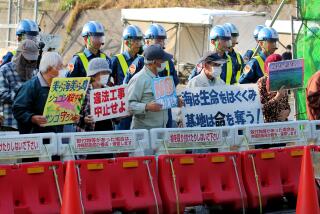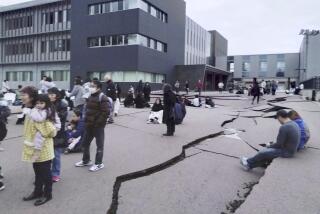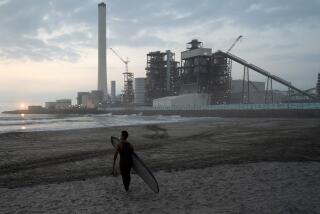Japan clears discharge of some radioactive water into sea
Reporting from Tokyo — The operator of Japan’s crippled Fukushima Daiichi nuclear plant began releasing thousands of tons of radioactive water into the sea Monday evening under an emergency measure approved by the government to make room in storage tanks for far more severely contaminated water.
About 10,000 tons of the water to be released was being taken from a communal storage facility near the No. 4 reactor. Another 1,500 tons was being released from near the No. 5 and 6 reactors — which have faced fewer problems than the other reactors. The amount of water being released is equivalent to the contents of more than four Olympic-size swimming pools.
The water being released has levels of radioactive iodine-131 at least 100 times the legal limit allowed for sea discharge, but the government approved the release to allow water with 100,000 times more radiation than water found in a normally functioning reactor to be removed from the basement of the turbine building at reactor No. 2 and stored elsewhere at the site.
Government officials said the release of the radioactive water into the sea would not pose a threat to humans. Health ministry official Taku Ohara said the ministry nevertheless was considering drawing up radioactivity food-safety standards for fish after high radiation levels were detected in a sand lance, a bottom-feeding fish, caught off the coast of Ibaraki prefecture.
Nuclear experts have assumed that radioactive iodine, which has a brief half-life, would become diluted in the ocean and decay too quickly to contaminate fish, but Monday’s finding has raised doubts, said Ohara.
“We think the level found poses no immediate risk to people’s health but the point is moot anyway because all sand lance caught in Ibaraki were disposed of,” Ohara said. By comparison, the level of radioactive iodine in the fish was twice as high as the limit for vegetables. Currently there are no standards for radioactivity in meat, eggs, fish and grains.
After more than three weeks of cooling the disabled Fukushima reactors by spraying them with thousands of tons of water from fire trucks, concrete pumpers and helicopters, Tokyo Electric Power Co. faces a growing problem of what to do with the vast amounts of contaminated water.
Removing the water from turbine buildings and other structures is vital to allowing workers to restore cooling functions to the site. But with limited facilities for storing the water, the utility and the government are now considering options such as putting it into a “floating island” offshore. Also being discussed is the installation of an undersea barrier, usually used to contain oil spills, that might slow the radioactive water’s move offshore.
Tepco reported no success Monday in its efforts to stop highly radioactive water from seeping into the ocean from a concrete pit near the No. 2 reactor. The utility believed that the leak was coming from an 8-inch crack and attempted to seal it with polymer, sawdust and shredded newspaper. When that failed, the utility dumped some white bath salts into a pipe near the pit to attempt to trace the flow of the water, but the tracer had yet to show up in the sea.
The company now suspects the leak may be coming from a trench leading to the pit and on Tuesday plans to pour a chemical into the gravel surrounding the trench to try to solidify the area and stop seepage, NHK news reported.
Chief Cabinet Secretary Yukio Edano announced that the government would modify its protocol on restricting vegetable sales from prefectures where significant amounts of radiation have been detected. Instead of banning shipments from an entire prefecture, radiation levels will be monitored weekly at the level of municipalities, and if the detected levels fall below government limits for three consecutive weeks, then shipments will be allowed.
Farmers have been pressing the government to ease restrictions, but the new procedures raised questions about whether municipalities were capable of carrying out thorough checks. Some farmers complained that the weekly testing would not be frequent enough and said their produce was still likely to go to rot.
In Fukushima prefecture, officials announced plans for monitoring radiation levels at 1,400 schools starting Tuesday; a new academic year is to begin Wednesday and many parents are worried about their children being exposed to radiation.
Fukushima officials also have begun checking radiation levels of products manufactured within the prefecture. Many businesses are nervous that their goods might be rejected by buyers unless they are certified as being free of contamination.
In the town of Namie, which sits northwest of the Fukushima plant, just beyond the 18-mile perimeter within which authorities have urged people to evacuate or at least stay indoors, high levels of cumulative radiation were recorded over an 11-day period beginning March 23, the government announced.
The accumulated radiation was 10.3 millisieverts over 11 days, assuming that a person stayed outdoors 24 hours a day. With the government saying that it could easily take months to bring the Fukushima plant under control, the readings are raising fresh questions about the dangers of radiation over a longer period and whether the government’s evacuation perimeter is wide enough. Exposure to 100 millisieverts is believed to raise one’s risk of cancer by 0.5%.
Despite widespread concern about radiation from Fukushima, the public appears to be divided over whether the government should review its use of nuclear power. The results of a poll by the national Yomiuri Shimbun newspaper published Monday showed that nearly half the respondents favored maintaining the current number of nuclear power plants, while almost a third said they wanted the government to cut back.
The National Police Agency said the death toll in the massive March 11 earthquake and tsunami stood at 12,259 as of Monday evening, with more than 15,000 people still listed as missing.
National broadcaster NHK reported that a dog rescued Saturday by coast guard officers from the roof of a destroyed house floating more than a mile off the coast of northeastern Japan had been reunited with its owner.
The owner of the dog, a 2-year-old mutt named Ban, said she saw the news of the rescue on TV over the weekend and contacted authorities immediately.
Hall is a special correspondent.
More to Read
Sign up for Essential California
The most important California stories and recommendations in your inbox every morning.
You may occasionally receive promotional content from the Los Angeles Times.











